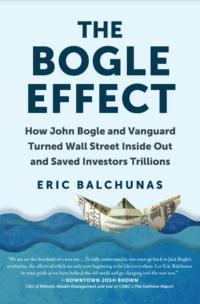Eric Balchunas, as many readers know, is the ETF Twitter King. He posts multiple times daily on the ETF industry and often has fresh takes and thoughts that drive the media cycle. In short, he’s a “must-follow.”
But Eric’s talents extend well beyond Twitter. Eric is an accomplished writer with numerous articles and an excellent/wonky book on the inside baseball on ETFs: “The Institutional ETF Toolbox.” His latest book, “The Bogle Effect,” takes a bit of a turn from his traditional work reporting on ETFs and the industry. He tackles a big question: “Just how influential was Jack Bogel on the asset management industry?”(1)
The full title of Eric’s book is “The Bogle Effect: How John Bogle and Vanguard Turned Wall Street Inside Out and Saved Investors Trillions“

- Eric Balchunas
- The book can be found here.
- Want to see all our book reviews?
What did I like about the book?
I went into this book expecting to be underwhelmed due to the topic. My immediate laundry list of concerns:
- Seriously, a book on Jack Bogle?
- He created index funds. He ripped out all fees and made the asset management business suck.
- For the rest of his life, he’s talked about why high fees and active managers were devil-worshippers.
Boooooorrrriiiiinnnng
It turns out, my gut reaction to opening this book wasn’t that different than Matt Hougan’s, who wrote the foreword on the book:
I didn’t expect to learn much from this book.
Boy, was I wrong. This book went deep and got me thinking about a lot of things.
But first, what is this book about?
Here are the chapters
- The Vanguard Colossus
- Declaration of Independence
- Average is the New Great
- Explaining Bogle
- The Fall (and Rise) of Active
- Bogle and ETFs: It’s Complicated
- The Great Cost Migration
- Some Worry
- Bogle vs. Vanguard
- The Art of Doing Nothing
For me, the best chapter was Bogle vs. Vanguard, which highlights the tension between Bogle and Post-Bogle-Vanguard. In many ways, Jack’s concerns are playing out in real-time and should be monitored by financial media and Vanguard shareholders.
The tensions that were most interesting to me were the following (with my 2 cents added):
- AUM size: Jack was concerned that Vanguard would become a monstrous bureaucracy that could get crushed under its own weight.
- I see this as a very real threat to Vanguard.
- ETF growth: Jack didn’t like the fact that ETFs could be traded very easily — essentially destroying the long-term nature of the underlying investments ETFs were supposed to represent.
- To me, this is less of a concern. Behavioral issues will certainly increase with ETFs, but I think the benefits of the wrapper outweigh the costs.
- Voting record: Vanguard owns a lot of everything, and Jack was concerned that Vanguard wasn’t active enough in being stewards for shareholders.
- This topic is very interesting because Vanguard has gone from being very passive on how they vote to become more active. And, of course, the concentration of power at Vanguard, iShares, and even SSGA has created an ability to affect large-scale change without going through a political process. We’ll be watching this one play out.
- Extra-curricular activities: Bogle’s issue was that Vanguard might be losing its focus on what brought it success first: low-cost index funds.
- Vanguard has quickly pivoted into areas they are not known for: Quant funds, private equity, financial advisory services, etc. There seems to be mixed success in all these areas. I agree with Bogle’s sentiment and see the lack of focus as a potential canary in the coal mine for Vanguard.
Constructive criticisms
We always like highlighting constructive criticism of a book, to ensure we are paying attention. No piece of work is perfect, because books are not written for an audience of one — they are designed to reach an audience of many. For me, as an industry insider, a large portion of this book is not new because it is simply recapping a lot of materials and ideas that I’m already familiar with. But that’s okay, and maybe it highlights that this isn’t the greatest Christmas gift for someone who has been in the ETF business for 10+ years. That said, for folks not in the financial services industry, or those less familiar with the ETF world, a lot of the content will likely be interesting and enlightening.
Summary
Eric has done a wonderful job outlining the influence Jack Bogel had on the financial services industry. Many of the lessons learned and the stories told are likely relevant to other industries plagued by sleepy players that lack a focus on customer outcomes. I highly recommend you consider this book as a stocking stuffer for any business geeks you know.
About the Author: Wesley Gray, PhD
—
Important Disclosures
For informational and educational purposes only and should not be construed as specific investment, accounting, legal, or tax advice. Certain information is deemed to be reliable, but its accuracy and completeness cannot be guaranteed. Third party information may become outdated or otherwise superseded without notice. Neither the Securities and Exchange Commission (SEC) nor any other federal or state agency has approved, determined the accuracy, or confirmed the adequacy of this article.
The views and opinions expressed herein are those of the author and do not necessarily reflect the views of Alpha Architect, its affiliates or its employees. Our full disclosures are available here. Definitions of common statistics used in our analysis are available here (towards the bottom).
Join thousands of other readers and subscribe to our blog.

